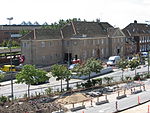Glostrup Municipality

Glostrup Kommune is a suburban municipality (Danish kommune) and town in Region Hovedstaden on the island of Zealand (Sjælland) approx. 10 km west of Copenhagen in eastern Denmark. The municipality covers an area of 13.31 km², and has a total population of 23,635 (2023). Its Zip code (Postnummer) is 2600. Its mayor as of 2022 is Kasper Damsgaard, a member of the Social Democrats (Socialdemokratiet) political party. The municipality was established in 1841 following the municipal reforms of the 1840s, ranking as a parish municipality (sognekommune) until 1950 when suburbanisation of Copenhagen inhabited the municipality and the status was changed to town municipality (købstadskommune). From 1947 to 1960 the population in the municipality doubled due to the expanding suburbs of Copenhagen, reaching the municipality in the post-war period. Glostrup was designated as a new suburb along the western Tåstrup-finger of the Copenhagen Finger Plan of 1947. The main town and the site of its municipal council is the town of Glostrup, home to three quarters of the population. Other towns in the municipality are Hvissinge and Ejby. Until 1974 the town of Avedøre also belonged to this municipality. Being an exclave, it was merged into the neighbouring Hvidovre Municipality. Neighboring municipalities are Rødovre to the east, Herlev and Ballerup to the north, Albertslund to the west, and Brøndby to the south. Glostrup was not merged with other municipalities on 1 January 2007, as the result of nationwide Kommunalreformen ("The Municipality Reform" of 2007). The church of Glostrup originates from the 12th century.
Excerpt from the Wikipedia article Glostrup Municipality (License: CC BY-SA 3.0, Authors, Images).Glostrup Municipality
Højvangsvej, Glostrup Municipality
Geographical coordinates (GPS) Address Nearby Places Show on map
Geographical coordinates (GPS)
| Latitude | Longitude |
|---|---|
| N 55.666666666667 ° | E 12.4 ° |
Address
Højvangsvej
2600 Glostrup Municipality
Capital Region of Denmark, Denmark
Open on Google Maps







